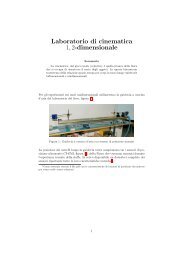Newton's law of cooling revisited - Cartan
Newton's law of cooling revisited - Cartan
Newton's law of cooling revisited - Cartan
Create successful ePaper yourself
Turn your PDF publications into a flip-book with our unique Google optimized e-Paper software.
Newton’s <strong>law</strong> <strong>of</strong> <strong>cooling</strong> <strong>revisited</strong> 1081<br />
Figure 16. Examples <strong>of</strong> investigated light bulbs. Samples were placed in front <strong>of</strong> a room<br />
temperature cork board (top, left). Analysis <strong>of</strong> IR images (top right)reveal that halogen light bulbs<br />
reach maximum temperatures >330 ◦ C (bottom) with small relative temperature variations. The<br />
heating and <strong>cooling</strong> <strong>of</strong> the halogen light bulb covers a temperature difference range <strong>of</strong> more than<br />
300 K.<br />
even at 50 K. In the case <strong>of</strong> figure 15, deviations already amount to more than 15 K at �T =<br />
100 ◦ C. For temperature differences below 50 ◦ C, deviations are below 2.5 ◦ C. These numbers<br />
would decrease if the upper temperature difference for the fit increased.<br />
6.3. Light bulbs: �T � 300 K<br />
The Al metal cubes could not be heated to the high temperatures needed to observe really<br />
large deviations <strong>of</strong> T(t) from the simple exponential <strong>law</strong>. In order to study higher temperatures<br />
experimentally, we used light bulbs. Several light bulbs <strong>of</strong> different power consumption<br />
and size were tested. Experiments were performed with small halogen light bulbs (near<br />
cylinder diameter 11 mm and height 17 mm). Their Biot number is much smaller than unity<br />
(table 1). Figure 16 shows the lamp and an IR image <strong>of</strong> the halogen bulb while hot as well as<br />
measured surface temperatures during a heating and <strong>cooling</strong> cycle.<br />
In the following analysis, the maximum temperatures in a small area around the top <strong>of</strong><br />
the light bulb were used (a test using average rather than maximum temperatures within the<br />
indicated area showed that the general form <strong>of</strong> normalized T(t) curves as in figure 16 changed<br />
very little).




